MSI Megabook S271: a Look at AMD's Turion X2
by Jarred Walton on October 16, 2006 12:05 AM EST- Posted in
- Laptops
Internals and Construction
We mentioned that the system we originally received was essentially the base model, and since we really wanted to look at Turion X2 performance potential we had to perform some upgrades. That gave us a chance to tear open the system and see how it was put together.
One of the first major issues we have with the design becomes immediately apparent when you decide to make even the simplest upgrade. The vast majority of laptops include a small access panel on the bottom of the system that allows you to upgrade memory. Unfortunately, other than the battery latch and some ventilation, there really isn't much to see on the bottom of the laptop. If you want to add memory, you will have to pop the hood, and as with most laptops this requires removing several screws -- six to be exact. As is typical of most laptops, you will need a small Phillips head screwdriver in order to accomplish this.
With the screws on the bottom removed, you should be able to use your fingers to pry open the front of the case. We found it was easiest to start at the left front corner, and then work your way around to the front right corner. Once this is done, you can carefully lift off the front plastic panel which includes the trackpad.
This piece is connected to the rest of the system by a ribbon cable, so be careful not to lift/pull it too far until you detach the cable. If you are working on a flat surface, you don't actually need to detach the ribbon cable, which is one less step to worry about if all you're trying to do is upgrade memory or hard drive.
At this point, you can lift the keyboard up, exposing access to the memory slots. The keyboard is also attached by a ribbon cable, and if you don't need to do more than swap/add memory you should be able to do this without detaching the cable. Just be careful not to pull on the ribbon cable too much, as they can be damaged. We removed the cable and keyboard completely in order to get a good shot of the memory slots, which are covered by a thin sheet of foil/insulator. In the above picture, we have two Corsair 1GB SO-DIMMs installed. If you wanted to upgrade your hard drive, one more screw secures the drive bay, and once you remove that you can lift the drive out.
Getting down to the CPU requires a bit more work. First you have to remove the large plastic and aluminum panel. This is secured by one more screw on the bottom rear of the chassis and seven screws on the top of the panel. You also need to remove the hard drive in order to remove this panel. Once you have all the screws removed, you have to pry up the plastic sides in a manner similar to how you first open the case, and then slide the panel up and out. It takes a bit of effort, but if you find that any portions of the panel seem to be stuck check again and make sure you have removed all of the necessary screws.
With that panel out of the way, you can see the relatively large heatsink, heatpipe, and fan assembly that cools the processor, chipset, and some of the voltage regulators. There are actually only four screws holding the heatsink in place, all in the top left portion in a rectangular arrangement. The screws won't actually come all the way out as they are connected to the heatsink, so all you have to do is loosen them and then carefully lift/pry off the cooling assembly.
When you got all that done, it's pretty easy to remove the old processor and install a new processor. We did have to scrape off the old thermal pad before installing the new processor, as it had become hard and would likely have caused issues with cooling the processor. We used some inexpensive thermal paste when we installed the TL-60 (and later when switching back to the TL-50), and in subsequent testing we didn't notice any substantial difference in temperatures or stability. Once you've installed the new processor, reverse the whole process to put the system back together and you're done.
Here's a quick shot of all the pieces you will have won the system is completely disassembled. This is a picture of the bottom of all these components, since we already had various images of the tops. All told, the disassembly and upgrade process was one of the more inconvenient laptops we've dealt with, but as most people will only have to do this once or twice during their ownership of the laptop it shouldn't present too big a problem. However, given that we were testing several different configurations and had to disassemble and reassemble the system quite a few times, we grew to be none too fond of the overall design.
Besides the requirement that you take apart the front of the system just to swap memory, we encountered some problems with the wireless mini-PCI card, likely caused by our poking around inside the case. When the laptop first arrived, the wireless networking worked fine (once we got the proper drivers installed). After our first "upgrade", Windows wireless networking could no longer find our network. After a lot of trial and error, we determined that we must have bumped the card or wires in some fashion that affected the ability for the card to receive signals. We checked the connections and everything looked fine, but the WiFi networking still refused to work. We opened up the laptop again and played around with the card and the connections a bit more, turned the system back on, and the wireless network was back.
Unfortunately, it seemed every time we opened the case there was a good chance that the wireless network would fail, and eventually we reached the point where we were unable to get the wireless adapter to function anymore. Windows didn't indicate any problems other than the inability to see any networks, so most likely it was simply some point of failure in the WiFi antenna that runs throughout the chassis or on the card itself. We have used other laptops that also include bottom panel access to the mini-PCI slot, and it certainly seems that there are better locations than MSI chose, although it is also possible that we just got a flaky wireless networking card in our review unit. Our overall impression of the RALINK wireless networking card is lackluster at best, and we also discovered at one point when the card was working that the latest drivers had a severe memory leak. Thankfully, you don't have to use the RALINK networking application.
We mentioned that the system we originally received was essentially the base model, and since we really wanted to look at Turion X2 performance potential we had to perform some upgrades. That gave us a chance to tear open the system and see how it was put together.
One of the first major issues we have with the design becomes immediately apparent when you decide to make even the simplest upgrade. The vast majority of laptops include a small access panel on the bottom of the system that allows you to upgrade memory. Unfortunately, other than the battery latch and some ventilation, there really isn't much to see on the bottom of the laptop. If you want to add memory, you will have to pop the hood, and as with most laptops this requires removing several screws -- six to be exact. As is typical of most laptops, you will need a small Phillips head screwdriver in order to accomplish this.
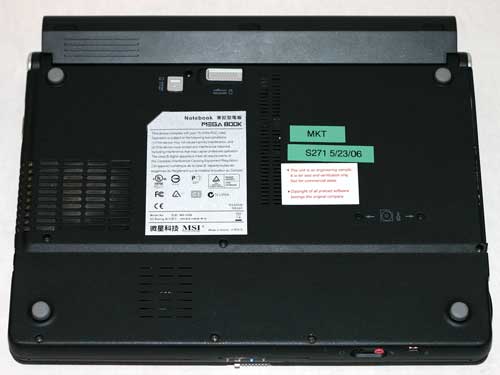 |
| Click to enlarge |
With the screws on the bottom removed, you should be able to use your fingers to pry open the front of the case. We found it was easiest to start at the left front corner, and then work your way around to the front right corner. Once this is done, you can carefully lift off the front plastic panel which includes the trackpad.
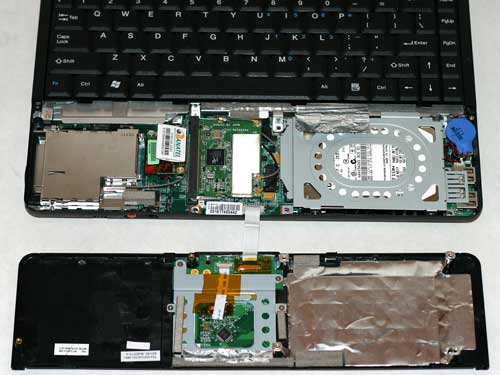 |
| Click to enlarge |
This piece is connected to the rest of the system by a ribbon cable, so be careful not to lift/pull it too far until you detach the cable. If you are working on a flat surface, you don't actually need to detach the ribbon cable, which is one less step to worry about if all you're trying to do is upgrade memory or hard drive.
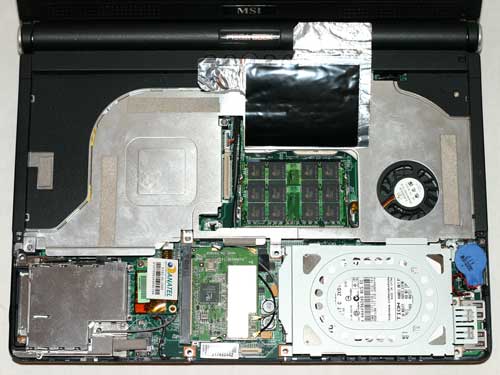 |
| Click to enlarge |
At this point, you can lift the keyboard up, exposing access to the memory slots. The keyboard is also attached by a ribbon cable, and if you don't need to do more than swap/add memory you should be able to do this without detaching the cable. Just be careful not to pull on the ribbon cable too much, as they can be damaged. We removed the cable and keyboard completely in order to get a good shot of the memory slots, which are covered by a thin sheet of foil/insulator. In the above picture, we have two Corsair 1GB SO-DIMMs installed. If you wanted to upgrade your hard drive, one more screw secures the drive bay, and once you remove that you can lift the drive out.
 |
| Click to enlarge |
Getting down to the CPU requires a bit more work. First you have to remove the large plastic and aluminum panel. This is secured by one more screw on the bottom rear of the chassis and seven screws on the top of the panel. You also need to remove the hard drive in order to remove this panel. Once you have all the screws removed, you have to pry up the plastic sides in a manner similar to how you first open the case, and then slide the panel up and out. It takes a bit of effort, but if you find that any portions of the panel seem to be stuck check again and make sure you have removed all of the necessary screws.
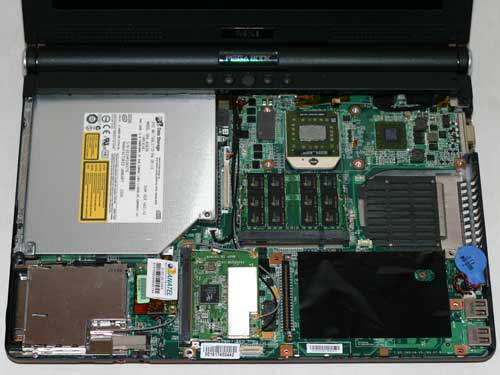 |
| Click to enlarge |
With that panel out of the way, you can see the relatively large heatsink, heatpipe, and fan assembly that cools the processor, chipset, and some of the voltage regulators. There are actually only four screws holding the heatsink in place, all in the top left portion in a rectangular arrangement. The screws won't actually come all the way out as they are connected to the heatsink, so all you have to do is loosen them and then carefully lift/pry off the cooling assembly.
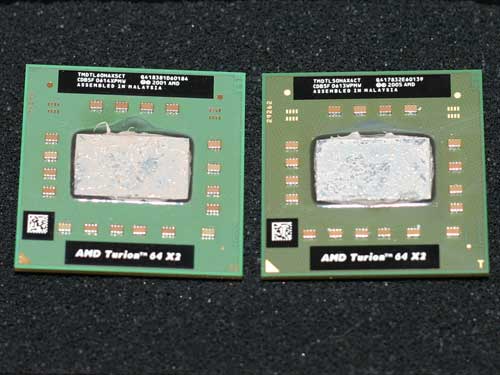 |
| Click to enlarge |
When you got all that done, it's pretty easy to remove the old processor and install a new processor. We did have to scrape off the old thermal pad before installing the new processor, as it had become hard and would likely have caused issues with cooling the processor. We used some inexpensive thermal paste when we installed the TL-60 (and later when switching back to the TL-50), and in subsequent testing we didn't notice any substantial difference in temperatures or stability. Once you've installed the new processor, reverse the whole process to put the system back together and you're done.
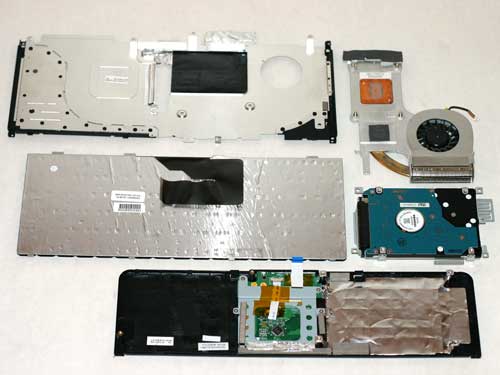 |
| Click to enlarge |
Here's a quick shot of all the pieces you will have won the system is completely disassembled. This is a picture of the bottom of all these components, since we already had various images of the tops. All told, the disassembly and upgrade process was one of the more inconvenient laptops we've dealt with, but as most people will only have to do this once or twice during their ownership of the laptop it shouldn't present too big a problem. However, given that we were testing several different configurations and had to disassemble and reassemble the system quite a few times, we grew to be none too fond of the overall design.
Besides the requirement that you take apart the front of the system just to swap memory, we encountered some problems with the wireless mini-PCI card, likely caused by our poking around inside the case. When the laptop first arrived, the wireless networking worked fine (once we got the proper drivers installed). After our first "upgrade", Windows wireless networking could no longer find our network. After a lot of trial and error, we determined that we must have bumped the card or wires in some fashion that affected the ability for the card to receive signals. We checked the connections and everything looked fine, but the WiFi networking still refused to work. We opened up the laptop again and played around with the card and the connections a bit more, turned the system back on, and the wireless network was back.
Unfortunately, it seemed every time we opened the case there was a good chance that the wireless network would fail, and eventually we reached the point where we were unable to get the wireless adapter to function anymore. Windows didn't indicate any problems other than the inability to see any networks, so most likely it was simply some point of failure in the WiFi antenna that runs throughout the chassis or on the card itself. We have used other laptops that also include bottom panel access to the mini-PCI slot, and it certainly seems that there are better locations than MSI chose, although it is also possible that we just got a flaky wireless networking card in our review unit. Our overall impression of the RALINK wireless networking card is lackluster at best, and we also discovered at one point when the card was working that the latest drivers had a severe memory leak. Thankfully, you don't have to use the RALINK networking application.










31 Comments
View All Comments
JarredWalton - Monday, October 16, 2006 - link
First, the "closed system" as such is not something we would recommend. Dual core with only 512MB of RAM? I already covered that. Second, the system *is* available as a barebones (MSI MS-1058), as I mentioned in the review. Memory compatibility aside, this isn't a great laptop. It's okay.The memory issues are something worth mentioning, even if we got them worked out. Even if everything had worked without issue, the laptop would have still only been okay - there are quite a few competing notebooks in the same price range, and this one fails to stand out from the crowd in any meaningful way.
Furen - Monday, October 16, 2006 - link
Sounds like you had huge memory compatibility problems, though. Personally, I always buy Crucial because when I used to buy other RAM (Kingston, etc), more often than not, I had some sort of memory compatibility problems (probably because I mixed brands but I've never had ANY problems at all with Crucial stuff).DrMrLordX - Monday, October 16, 2006 - link
I know the Core Duo is now an old product that is being replaced by the Core 2 Duo in the mobile sector, but it would have been nice to see the Turion X2 benchmarked against a Core Duo laptop as well. Surely a similarly-configured Core Duo machine exists out there somewhere.IntelUser2000 - Monday, October 16, 2006 - link
One thing is the Core 2 Duo laptop has 7200RPM HDD while the Turion X2 has 5400RPM. It shouldn't impact is greatly but it'll make a difference.IntelUser2000 - Monday, October 16, 2006 - link
Uhh. No. Clearly no. Explanation?? Turion X2 system uses integrated graphics, while Core 2 Duo system uses a powerful video card. Do you guys really think idle power of video card+chipset is equal to chipset alone??
IntelUser2000 - Monday, October 16, 2006 - link
http://www.computerbase.de/artikel/hardware/grafik...">http://www.computerbase.de/artikel/hard...hnitt_le...Integrated graphics power is clearly lower than even super low-end discrete. Now on this AT review we are talking about a mid-range part.
Sorry for triple post, but I must get my point across.
Two laptops, each possessed by one of my friends, both a Dell:
Pentium M 765 2.0GHz/533MHz FSB
1GB DDR2-533
120GB 5400RPM HDD
Geforce Go 7800GTX 128MB
15.4 inch wide-screen
70WHr battery
2.5 hour battery life with internet surfing, usage
2. Pentium M 1.6GHz/400MHz FSB/Dothan
512MB DDR2-533
Intel GMA900
60GB 4200RPM HDD
14 inch screen
45WHr battery
3.5 hour battery life with internet surfing, light usage
Is there a reason some high-end laptops are featured with integrated/discrete graphics card option?? You can turn one off?? Cause video cards in laptops suck huge amounts of power.
JarredWalton - Monday, October 16, 2006 - link
There are multiple issues involved with testing comparable laptops. Short of going out and purchasing a laptop, it's very difficult to pull off. At this point, there's not much reason to get a Core Duo notebook instead of a Core 2 Duo notebook, other than price. So we're doing our best to compare laptops that are similar, and we wanted to get this review out the door before it got any older. Obviously, we're still not recommending the MSI S271 over other laptops.In regards to Inteluser2000, he makes several comments. I have now reworded the page on power consumption to clarify a few points. However, not all of his points are entirely valid either. For example:
I don't think he was reading clearly, because I had just explained that at maximum CPU load MSI Turion X2 is consuming MORE power than ASUS Core 2 Duo. In other words, even with integrated graphics versus discrete graphics and with all of the other variables involved (7200 RPM hard drive versus 5400 RPM Drive, 14 inch LCD versus 12.1 inch LCD, etc.), without putting a load on the GPU one would expect the ASUS system to draw more power than the MSI system, and it doesn't. At idle, all of the variables can explain why the ASUS consumes more power, but when I put 100% load on just the CPU Turion X2 clearly requires more power.
I have no idea what he is trying to say with his comment about Dell laptops. Comparing a high-end system with a GeForce Go 7800 GTX to one that uses IGP is far worse than comparing something that uses GeForce Go 7700 to IGP. Different battery sizes, different display sizes, different processors, different hard drives, memory, etc. -- of course they're going to have different results. However, in this case are not drawing any final conclusions about idle power, other than to point out some interesting trends. What I am concluding is that if we were able to isolate just the CPU power use, a Turion X2 TL-60 at 100% load would require a lot more power than a Core 2 Duo T7200 at 100% load.
The ASUS system is there more as a frame of reference, particularly on the power requirements page. I really can't say for certain whether Turion X2 uses more power or less power at idle, but I am positive that it requires more power when it's placed under 100% load. Hope that explains things.
IntelUser2000 - Monday, October 16, 2006 - link
Nonono. I don't care about the load power, I care about your conclusions regarding idle. Even if you don't put load on the GPU, it consumes power. In laptop standards, lots of power. Its not a coincidence some laptop manufacturers put dual video card solutions(integrated/discrete), because they realize discrete cards affect battery life in idle, not just load. What I don't like is the explanation that its the CPU and chipset that contributes to idle power consumption and less battery life at DVD playback, Mobilemark, etc.
Check this out: http://www.trustedreviews.com/article.aspx?page=50...">http://www.trustedreviews.com/article.aspx?page=50...
(Dual GPU machine)
DVD playback
IGP: 164 minutes
Nvidia Geforce Go 6600: 112 minutes
MobileMark 2005 general battery life test
IGP:128 minutes
Geforce Go 6600: 92 minutes
30-40% battery life difference. Looks like video card is quite a big drain on battery life. I bet significant battery life difference between my friend's two system lies in the video card.
This is really a laptop review rather than a CPU review. Of course, due to laptops peculiarity of outperforming one with what looks like similar specifications, the idea of a CPU comparison on a laptop is far-fetched.
JarredWalton - Monday, October 16, 2006 - link
I did reword the rest of the page in regards to power use. I have used an ASUS W5F and found that it used about the same amount of power as the S271 (at idle). It was slightly more, so the remaining conclusions (i.e. Turion X2 in low power mode uses a bit less power) seem to be consistent. Tough to say 100% without nearly identical laptops - and you still have chipset and mobo components that can have an impact.IntelUser2000 - Monday, October 16, 2006 - link
You can find otherwise similar looking laptops that have different power consumption. How did you test out the W5F?? Just dropped in a Core 2 Duo in replacement of Core Duo?
Otherwise nice test.